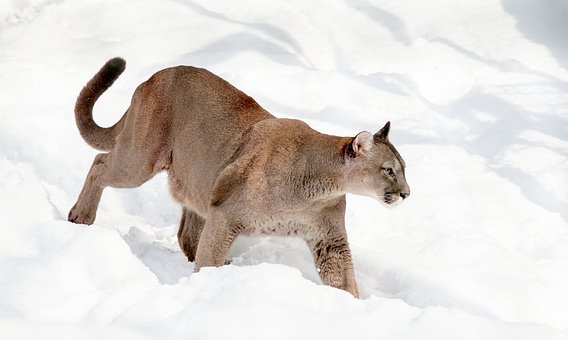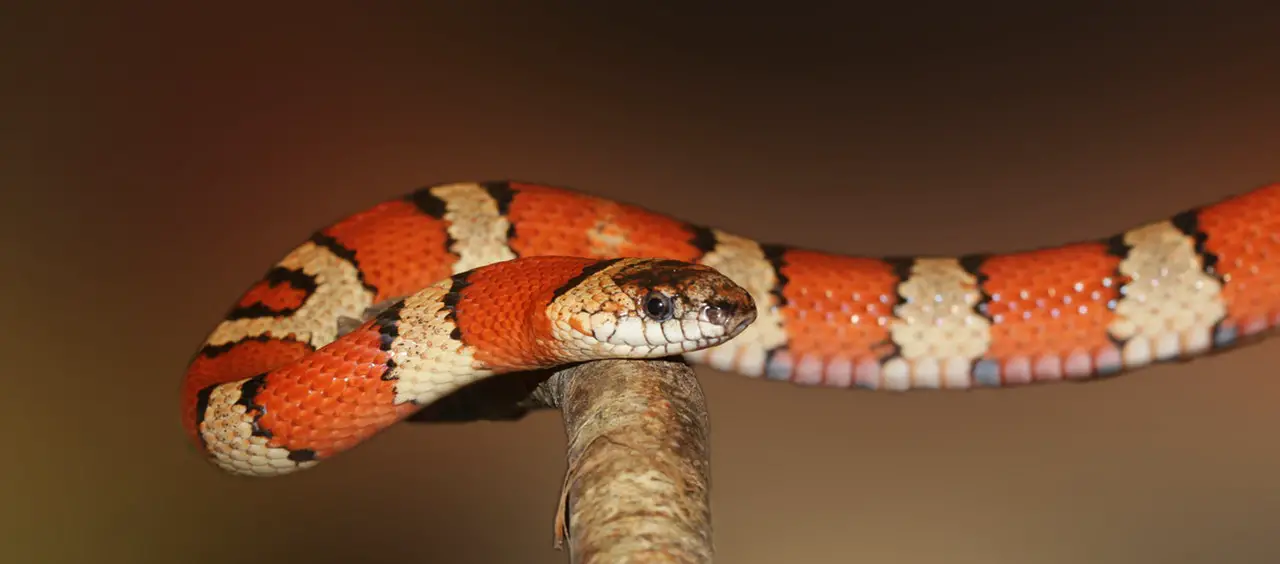Survival Skills: How to Survive If a Mountain Lion Attacks
 Survival Skills: How to Survive If a Mountain Lion Attacks
thegearhunt.com
Survival Skills: How to Survive If a Mountain Lion Attacks
thegearhunt.com
One question that is frequently asked by hikers is whether or not they need to worry about mountain lions on their hikes. The answer is both yes and no. Most of the time, mountain lions prefer to keep away from humans and will avoid hikers. However, it only makes sense to be wary of them, watch how they act and be ready for anything that might happen.
Most people will never even know when there is a mountain lion near them while they are hiking. In the next few paragraphs, you will learn how to understand their behavior, how to spot any mountain lion activity, and what to do if you ever come face to face with one.
The best way to see a mountain lion up close is at the zoo. Also, FYI, Florida panthers, pumas, cougars, and mountain lions are all the same thing.
How to Stop an Attack from a Mountain Lion
 If one of these creatures wants to attack you, you more than likely won’t see it coming. Yes, they are big cats, but they are extremely quiet and will stalk you before simply pouncing on you. Also, they tend to hang out in trees, but you might see one if they are curious and possibly sizing you up as their next meal.
If one of these creatures wants to attack you, you more than likely won’t see it coming. Yes, they are big cats, but they are extremely quiet and will stalk you before simply pouncing on you. Also, they tend to hang out in trees, but you might see one if they are curious and possibly sizing you up as their next meal.
If you ever do happen to see one before it attacks, NEVER TURN YOUR BACK OR RUN AWAY. These actions will signal to the lion that you are, in fact, prey. Typically, these animals will eat things like sheep and deer, but they are capable of eating things as small as mice to things as large as elk. In a day, they will generally eat as much as 10 pounds of meat. They only eat meat. If you see one, you will need to show it that you are not afraid, and you aren’t prey. Also, you need to understand that you will never be able to outrun one. They can reach speeds of 50 mph.
Here is what you should do if you encounter one in the wild:
- Never try to antagonize a mountain lion. Some say that you shouldn’t look them in the eye, but there isn’t any empirical evidence to support this. Just be sure that you don’t corner it, come at it, or threaten it.
- Wave your backpack, sticks, or whatever is at hand to make yourself seem scary.
- If you have any bear spray on you, be aware that it also works on mountain lions, so be ready to use it.
- If you happen to have a horn on you, give it a few blasts.
- If you happen to have hiking poles, be ready to use them if the animal approaches.
- Raise your hands into the air, make a lot of noise, and try to appear larger than you actually are.
Bear spray is a great thing to take on your hikes. It is useful in defending you against both bears and mountain lions.
Remember that once a mountain lion has decided that you aren’t prey, he will leave you alone.
If you ever do spot a mountain lion, you need to report it to the nearest rangers. If you have cell reception, call it in as soon as you spot it. If you don’t have any reception, call it in when you get back from your hike.
What to Do When Attacked by a Mountain Lion
 In most cases, the things listed above will be enough to make the mountain lion know that you aren’t a deer and can even scare it off. However, if you are noticing that it is beginning to charge you, you can use anything mentioned above to swing at it, or you can spray it in the face with your bear spray.
In most cases, the things listed above will be enough to make the mountain lion know that you aren’t a deer and can even scare it off. However, if you are noticing that it is beginning to charge you, you can use anything mentioned above to swing at it, or you can spray it in the face with your bear spray.
If a mountain lion decides that you are prey, you might not even see it coming. Typically, they will just ambush you and then attempt to crush the backside of your neck with a single bite. It really isn’t an ideal situation to find yourself in.
You should always remember that a mountain lion will spot you a long time before you see it.
If a mountain lion does decide that you are prey and attacks, here is what you should do:
- Focus on doing nothing but hitting back and surviving. Take it one punch at a time. Remind yourself that other people have survived attacks like this and you can survive too.
- If you have the bear spray clipped to your belt, and you haven’t used it, use it now to spray right in the face of the lion.
- Hit the critter in the head and around the eyes. The longer you are able to hit, punch, and fight it, the more you will be able to convince the animal that you are not, in fact, prey.
- Grab anything possible to fight it with. One woman in California was able to fend off a mountain lion with nothing but a ballpoint pen. Use your knife, rocks, sticks, just anything you can get your hands on and can hit the animal with. If nothing is near, use your fists.
If you are hiking with someone and they are attacked, use the same principles to fight the mountain lion. There are quite a few accounts of companions successfully saving their friends.
Gear for Mountain Lion Attacks
 If you happen to be truly afraid of being attacked by one of these felines, whenever you go hiking strap a knife and a bottle of bear spray to your belt or your pack. Make sure that they are ready to use if you find yourself on the ground with a mountain lion on top of you. This might be a bit of overkill, but fear affects people in different ways.
If you happen to be truly afraid of being attacked by one of these felines, whenever you go hiking strap a knife and a bottle of bear spray to your belt or your pack. Make sure that they are ready to use if you find yourself on the ground with a mountain lion on top of you. This might be a bit of overkill, but fear affects people in different ways.
Bear spray is an item that comes in aerosol spray cans that you can clip right onto your pack or your belt.
One strategy is to avoid being attacked and be vigilant for any signs of mountain lion activity, which we will discuss in a few minutes. If you think there might be a lion or two in the area where you will be hiking, clip a knife and bear spray on and hike with a pair of trekking poles.
Some people will also carry air horns, like the ones you might find on boats. You can get one of these at any type of hardware store, Amazon, Walmart, etc. The fact that this is easily available makes it a good choice.
Avoiding Being Attacked by a Mountain Lion
You might never see a mountain lion on a trail while you are hiking. However, you may see signs that they are there. Mountain lions tend to live anywhere they can find prey and concentrate themselves in Canada and the western part of the States, although they are also found in Florida. They live in both mountains and deserts, so you should always automatically assume that they are around. Most ranger offices are pretty good when it comes to posting notices and/or signs at any trailheads in areas where the lions have been spotted.
It is easy to tell if mountain lions are active in the area. Do you need to pull out the bear spray and knife when you see these things? Not really, but you need to be aware.
The trick to avoiding the mountain lions is to know the signs of them being active. If you notice a sign that one or more is in the area, take your trekking or hiking poles out, get the bear spray ready, and be cautious. You might want to make a lot of noise or even sing at the top of your voice. This is also good for keeping humans away. 😊 The typical range of a mountain lion is about 30 square miles, and this means that even if you notice signs of them, they could be miles away.
Activity Signs of Mountain Lions
Here is a quick look at some of the signs of mountain lions that you should be on the lookout for:
- Seeing fresh scat from a mountain lion. The issue with this though is identifying it. Typically, it can be large, about the same size as a normal human’s poop, especially in terms of circumference. At times, it may even have some of its prey’s hair in it. If it is warm and moist, it is new. If it is dry, it is old.
- The dead carcass of an animal. Especially fresh ones. Mountain lions will feed on carcasses whether or not they killed it.
- Seeing sheep, deer, or other large animals that could be prey for a mountain lion.
 Of course, if you notice fresh mountain lion tracks, that should be a dead giveaway that one of the big cats is in the area. However, unless you are an experienced tracker, or you happen to spot a track in snow, it can be difficult to know the age of it. Either way, tracks are a sign that one has been in the area and might either still be there or might come back. A mountain lion print is about 4 inches wide and 2 inches tall and you won’t notice any discernable claw or nail marks. Another marker is its toes. Look at the top two toes. If one seems to be longer than the other one, it is a mountain lion. If they are both the same length, it could be a dog paw print. Also, the hind foot of the mountain lion will go right into the print made by its front foot. This can mean that the patterns overlap.
Of course, if you notice fresh mountain lion tracks, that should be a dead giveaway that one of the big cats is in the area. However, unless you are an experienced tracker, or you happen to spot a track in snow, it can be difficult to know the age of it. Either way, tracks are a sign that one has been in the area and might either still be there or might come back. A mountain lion print is about 4 inches wide and 2 inches tall and you won’t notice any discernable claw or nail marks. Another marker is its toes. Look at the top two toes. If one seems to be longer than the other one, it is a mountain lion. If they are both the same length, it could be a dog paw print. Also, the hind foot of the mountain lion will go right into the print made by its front foot. This can mean that the patterns overlap.
Be Vigilant When You Rest
We already discussed mountain lions liking prey that is easy to kill or smaller. When you sit or crouch, you can be making yourself much more attractive to them. It might even trigger a natural instinct for them to attack.
There is more than one case of hikers being attacked when crouching to tie their shoes or sitting as they rest. Just keep in mind that this is not a good thing to do.
Yes, it can be tough to not sit or crouch, and that isn’t necessarily what I am suggesting you do. Look at it like this – when you are sitting around your campfire while you are camping, are you constantly worried that a mountain lion will get you? Of course not, but you are still cautious. Especially when you know that they are active in the area. The same holds true for hiking. Just be aware of your surroundings and be cautious.
Kids and Dogs can be Targets
 Due to the fact that dogs and children are small and tend to appear to be easier prey, if you are hiking with either, you need to be sure to take a few extra precautions.
Due to the fact that dogs and children are small and tend to appear to be easier prey, if you are hiking with either, you need to be sure to take a few extra precautions.
When you are hiking with kids, keep them near you, and never let them wander off. If you happen to spot a big cat, grab the child and pick them up. At the very least, keep them close to your side. It will make you appear larger.
When it comes to dogs, there are a couple of ways to think about it. The first thing is that dogs tend to be more aware than humans and will let you know when a mountain lion is in the area. They might even scare them off.
The other thing is that dogs are similar to coyotes. Mountain lions can eat coyotes. If you keep the animal on a leash, it can alert you to any danger, but you will also be able to pull it closer so that you can protect it. Dogs and people together probably won’t appear to be easy prey.
Be Practical
Yes, mountain lions can be scary. Should that fear keep you from enjoying the outdoors or hiking? No. If you read this entire article, you now have the tools you need to coexist successfully with the big cats in the wild. If you want empirical facts, here you go:
You have a better chance of actually poisoning yourself than being attacked by a mountain lion.
You also have a better chance of being killed in traffic on your way to the trails. 36,000 people in America die each year from traffic accidents.
Between the years of 1986 and 2014, only 14 mountain lion attacks on humans were verified in California.
Just keep in mind what you have read here today, be cautious, and enjoy the trails.
Sources
- You Tube, How to Survive Mountain Lion Attacks
- Wide Open Spaces, How to Survive a Mountain Lion Attack
- Escaping the Midwest, How to Survive a Mountain Lion Attack
- I Save A to Z, How to Survive a Mountain Lion Attack















